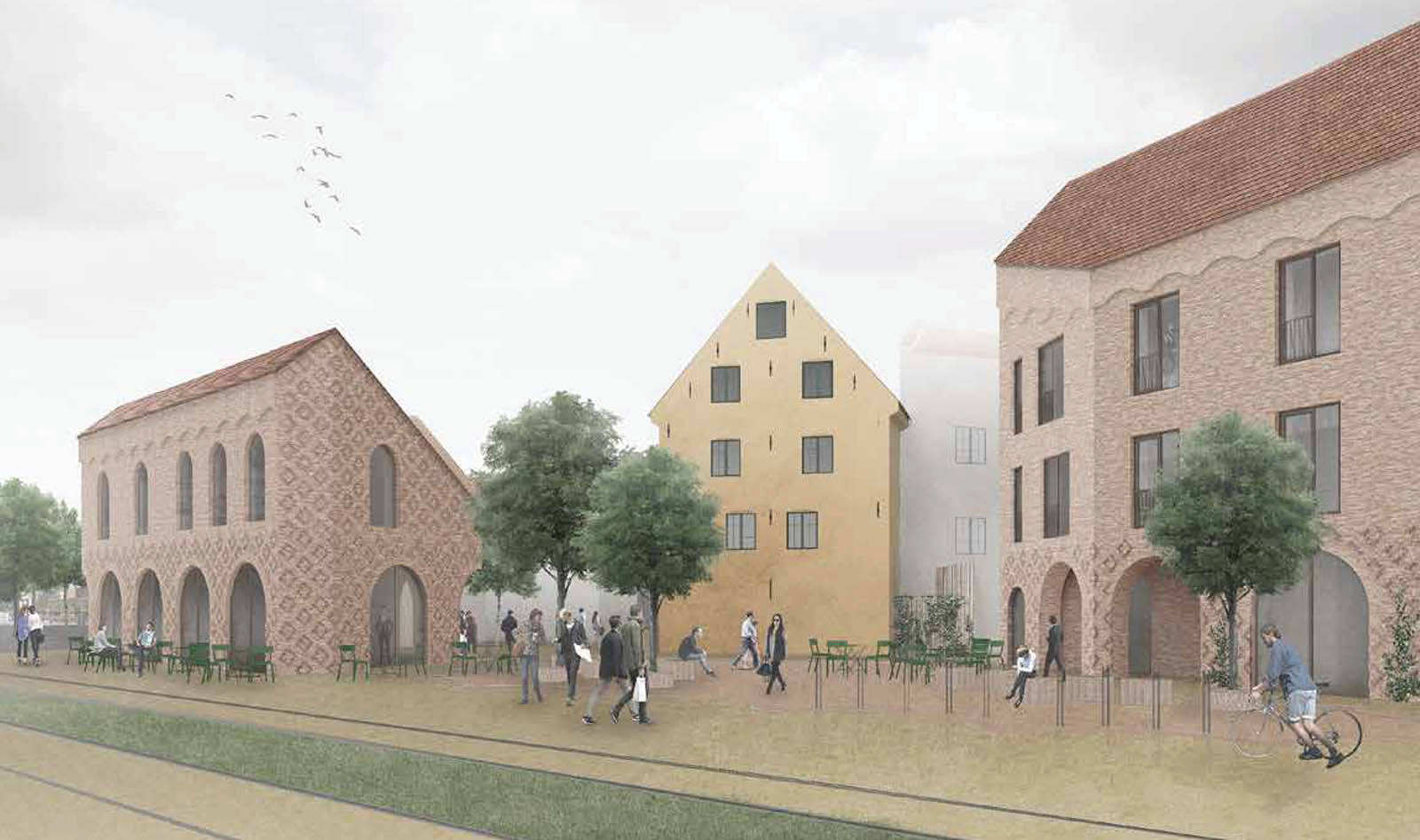Two lenses of criticism for the green facades of Oluf Bager Plaza in Odense, Denmark
Downloads
DOI:
https://doi.org/10.7480/spool.2018.1.1939Keywords:
Design Critique, Green facades, Green architecture, Green city development, Dense city, Urban transformation, Landscape Architecture, Thomas B. Thrige StreetAbstract
Increasingly celebrated, often without questioning, “green architecture” calls for a substantiated discussion. This article explores how design critique can contribute to the thinking and practice around green architecture, particularly green facades, which are growing in number and significance. How can green facades be critically discussed, beyond the dominating glossy project presentations and quantitative measurements of technological and ecological aspects? This article studies the green facades in the architectural competition, Oluf Bager’s Plaza, 2016, in Odense, Denmark, using two traditions of critique: Noël Carroll’s art criticism, in which green facades are seen as part of a designed work that follows certain intentions, and Mary McLeod’s concept of architecture as public domain that requires critical attention towards broader cultural, social, and economic processes. The study shows that the projects for the new Oluf Bager’s Plaza strike a balance between different ambitions, mainly adjusting to the historical context, while also answering the paradoxical double aim of Odense to become a densely built yet green city. The assumption that green facades can bridge the gap between density and green-ness became an important premise for the project. Green architecture should therefore be critiqued from multiple angles, including the ideas, plans, politics, and economics that shape future cities.
How to Cite
Published
License
Copyright (c) 2020 SPOOL

This work is licensed under a Creative Commons Attribution 4.0 International License.

References
Braae, E. M., & Riesto, S. (2017). Designing Urban Natures:
Ambiguities in urban space design on the threshold of climate disaster. Kritische Berichte, 45(2): 92-101.
Carroll, N. (2009). On Criticism, Thinking in Action. London and New York: Routledge
Dunnett, N., & Kingsburg, N. (2009). Planting Green Roofs and Living Walls. Portland, OR: Timber Press Inc.
Elkins, J.; & Newman, M., (Eds.) (2008). The State of Art Criticism. London and New York: Routledge.
Entasis. (2012). Helhedsplan: TBT5000c (Masterplan for Thomas B: Thrige street, second edition). Copenhagen, Denmark.
Entasis, Odense Municipality; Realdania. (2013). Fra Gade til By: Omdannelse af Thomas B. Thriges Gade (Masterplan for Thomas B. Thrige street, final version) Odense, Denmark.
Entasis; LETH & GORI; Maali & Lalanda MLAS; Praksis Architects. (2016, May). Project presentations. Realdania By & BYg in Odense, Denmark.
Gandy, M. (2002). Concrete and Clay: Re-working Nature in New York City. New York, NY: MIT Press.
Gandy, M. (2010). The ecological facades of Patrick Blanc. Hoboken, NJ: John Wiley & Sons Ltd.
Green Wall: ArchDaily. (2017, June 14). Retrieved from https://www.archdaily.com/tag/green-wall/
Hunter, A.M., Willams, S.G., Rayner, J.P., Aye, L., & Hes, D., Livesley, S.J. (2014). Quantifying the thermal performace of green facades: A critcal review. Ecological Engineering 63:102-113
Ignatieva, M., & Ahrné, K. (2013). Biodiverse green infrastructure for the 21stcentury: from “green desert” of lawns to biophilic cities. Journal of Architecture and Urbanism, 37:1, 1-9. London, England: Routledge.
Kellert, S.R., Heerwagen, J.H., & Mador, M.L. (2008). Biophilic Design: The Theory, Science and Practice of Bringing Buildings to Life. Hoboken, NJ: John Wiley & Sons Ltd.
Köhler, M. (2008). Green facades – a view back and some visions. Urban Ecosystems 11:423–436, Springer Science + Business Media.
McLeod, M. (1987). On Criticism [Criticism of Place: A Symposium], Places Journal 4 (1). Retrieved from https://placesjournal.org/assets/legacy/pdfs/on-criticism-mcleod.pdf
Millennium Ecosystem Assessment (2005). Ecosystems and Human Well-being: Synthesis. Washington DC: Island Press. Retrieved from http://www.millenniumassessment.org/documents/document.356.aspx.pdf
Mostafavi, M., & Doherty, G. (2010). Ecological Urbanism. Zürich, Switzerland: Lars Müller Publishers.
Odense Municipality. (2012). Lokalplan 0-732: Omdannelse af Thomas B. Thriges Gade (district plan). Odense, Denmark.
Odense Municipality. (2014). Lokalplan 0-770: Thomas B. Thriges Gade omkring Skulkenborg (district plan). Odense, Denmark.
Odense Municipality. (2015). Ny Odense: Fra stor dansk by til dansk storby (Municipal Plan 2016-2028). Odense, Denmark.
Odense Municipality. (2015). Ny Odense: Fra Dansk Stor By til Dansk Storby (Plan strategy 2015). Odense, Denmark.
Ottelé, M., Perini, K., Fraaij, A.L.A., Haas, E.M., Raiteri, R. (2011). Comparative life cycle analysis for green facades and living wall systems. Energy and Buildings 43: 3419-3429.
Perini, K., Ottelé, M., Fraaij, A.L.A., Haas, E.M., & Raiteri, R. (2011). Vertical greening systems and the effect on air flow and temperature on the building envelope. Building and Environment 46: 2287-2294.
Picon, A. (2015). Smart Cities: A Spatialised Intelligence. Hoboken, NJ: John Wiley & Sons Ltd.
Realdania (2017, June 14). Retrieved from www.realdania.dk/samlet-projektliste/thomas-b-thriges-gade
Realdania By & Byg. (2016). Oluf Bagers Plads: 2 nye huse og en plads (Competition program). Odense, Denmark.
Realdania By & Byg. (2016). Kommentarer til viderebearbejdning af konkurrenceforslag i Fase 2 [Comments to second phase of competition]. Odense, Denmark.
Realdania By & Byg. (2016). Oluf Bagers Plads: 2 nye huse og en plads (Competition program). Odense, Denmark.
Riesto, S. (2018). Biography of an Industrial Landscape: Carlsberg’s urban spaces retold. Amsterdam, Netherlands: Amsterdam Uiversity Press 2018.
Schmidt, M. (2009, June). Rainwater Harvesting for Mitigating Local and Global Warming. Fifth Urban Research Symposium: Cities and Climate Change: Responding to the Urgent Agenda. Marseille: SDG Knowledge Hub.
Schneider, T., & Till, J. (2009). Beyond Discourse: Notes on Spatial Agency. FOOTPRINT (4). 97-112. doi:10.7480/footprint.3.1.702
Sheweka, S., & Magdy, N. (2001). The Living walls as an Approach for a Healthy Urban Environment, Energy Procedia 6 (2011) 592–599.
Sieverts, T. (1997). In M. Stadler (Ed.). Where We Live Now: An Annotated Reader. Portland, OR: Verse Chorus Press.
Spirn, A. (1984). Granite Garden. Urban Nature and Human Design. New York, NY: Basic Books.
van Dooren, N. (2017). The landscape of critique: The state of critique in landscape architecture and its future challenges. SPOOL, 5(1). Retrieved from https://journals.open.tudelft.nl/index.php/spool/article/view/1936
van Uffelen, C. (2017). Green, greener, greenest: Facades, Roofs, Indoors. Salenstein, Switserland: Braun Publishing AG.
Wong, N.H., Tan, A.Y.K., Chen, Y., Sekar, K., Tan, P.Y., Chan, D., Chiang, K., & Wong, N.C. (2010). Thermal evaluation of vertical greenery systems for building walls. Building and Environment 45 (2010) 663–672.
Zaera-Polo, A., Koolhaas, R., & Boom, I. (2014). The Elements of Architecture #7: façade. Venezia,Italy: Marsilio.



